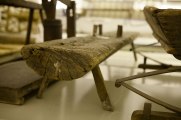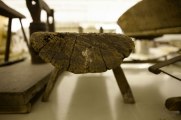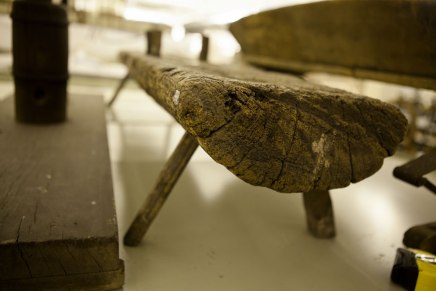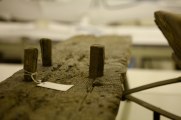
I’ve seen a blurry photograph of a detail of Chester Cornett’s chairmaking workbench and read Michael Owen Jones’s description of the bench in “The Craftsman of the Cumberlands.” At the time I thought: That sounds like a Roman-style workbench.
And yesterday I found out that I was correct.
Brendan Gaffney and I visited the storeroom of the Mathers Museum of World Culture in Bloomington, Ind., to view artifacts related to Cornett. And we got more than we bargained for. In addition to some of Cornett’s traditional chairs and rockers, the Mathers also had Cornett’s incredible “bookcase rocker” (more on that from Brendan in a future entry), a chair made by Cornett’s grandfather, Cornett’s worn-down Pexto drawknife, his worn-out dumbhead shavehorse and his workbench.
Located on the top rack in the storeroom, the workbench is a segment of a log with four staked legs. The workholding consists of three pegs that Chester could wedge his work between – exactly as described by M. Hulot in his 18th-century book on turning and chairmaking.
I’m pretty sure that Cornett didn’t read Hulot. So it is an amazing thing to see this low Roman-style workbench made by a 20th century woodworker who lived in the wilds of Eastern Kentucky. Did he come up with the idea for the bench himself? Was it something he learned from his family members who also were chairmakers?

The bench is 11” wide at the top and the benchtop is 10” from the ground. The log segment is 4” thick at its thickest point and about 62” long. The four legs are about 1” to 1-1/4” thick and wide x 8” long (minus their tenons).
So this is just another data point showing that low workbenches, as described in “Ingenious Mechanicks,” haven’t disappeared.
— Christopher Schwarz





